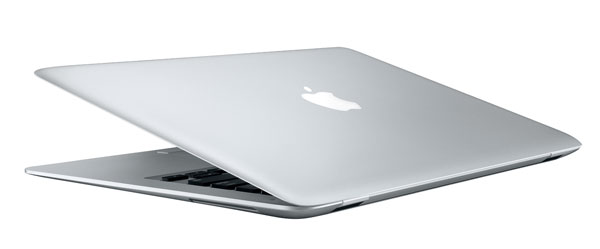Apple MacBook Air

As stylish a notebook as you could hope for, but in its quest for thinness, Apple has sacrificed a lot. It's lovely to use in many respects but one can't help feeling that the Air is a triumph of style over practicality.

Beneath the display is the fetching MacBookAir logo, while above this is a tiny iSight camera - Apple's name for its webcam and a small green light illuminates when it's active. Despite it size, it gave acceptable results in PhotoBooth and Skype.
Considering the need to keep the screen thin, there's no surprise that the display employs an LED backlight, and at maximum levels it's way too bright. However, once you tone it down a few notches it's perfectly usable with none of the patchiness that plagues some screens. The native resolution is a rather modest 1,280 x 800, merely the same as that on the smaller 11in display of the Sony TZ series.
The keyboard is essentially the same one you'll find on the regular MacBook. The keys have a fairly short amount of travel to them, and as long as you don't bash away it's a fine keyboard. Access to the F-keys is only via the Function key as by default they are mapped to shortcut functions, such as brightness, volume and iTunes control. One is also mapped to the excellent Expose, which lets you see all your open windows at once. One of these keys is mapped to the eject key, even though there is no integrated optical drive.
A great touch is the keyboard backlighting. This is tied to an ambient light sensor that controls the level of illumination. It's a great feature that not only makes it easier to type in dimly lit surroundings, but also looks very cool.
As there's no integrated optical drive Apple has optional external USB DVD burner available for the Air. I say custom, as the drive cannot be used with any other Mac, only with the Air, which seems a rather odd restriction. The Air Superdrive is as slick looking as you would imagine, but if you don't want to pay the 65 for one, Apple has come up with a neat alternative - Remote Disc. This involves making use of the optical drive of another machine, either PC or Mac. It involves installing some supplied software first, and on a Windows Vista machine it worked smoothly.
This makes it suitable for installing software or copying over medium sized files but copying speeds will depend on how fast your Wi-Fi connection is. That's because Wi-Fi is the only means of networking from the Air (unless you count the integrated Bluetooth). In its quest for miniaturisation, Apple omitted any kind of Ethernet port. The wireless supports the b/g and draft-n standards, but there will certainly be times when you're going to miss the security and reliability of a wired connection. There are many businesses who will not want to entrust their sensitive data even over a secured wireless connection.
Sign up today and you will receive a free copy of our Future Focus 2025 report - the leading guidance on AI, cybersecurity and other IT challenges as per 700+ senior executives
Benny Har-Even is a twenty-year stalwart of technology journalism who is passionate about all areas of the industry, but telecoms and mobile and home entertainment are among his chief interests. He has written for many of the leading tech publications in the UK, such as PC Pro and Wired, and previously held the position of technology editor at ITPro before regularly contributing as a freelancer.
Known affectionately as a ‘geek’ to his friends, his passion has seen him land opportunities to speak about technology on BBC television broadcasts, as well as a number of speaking engagements at industry events.
-
 AI is creating more software flaws – and they're getting worse
AI is creating more software flaws – and they're getting worseNews A CodeRabbit study compared pull requests with AI and without, finding AI is fast but highly error prone
By Nicole Kobie Published
-
 Cohesity deepens Google Cloud alliance in data sovereignty push
Cohesity deepens Google Cloud alliance in data sovereignty pushNews The pair’s expanded collaboration will focus on new integrations for AI, cybersecurity, and data protection
By Daniel Todd Published
-
 Cisco says Chinese hackers are exploiting an unpatched AsyncOS zero-day flaw – here's what we know so far
Cisco says Chinese hackers are exploiting an unpatched AsyncOS zero-day flaw – here's what we know so farNews The zero-day vulnerability affects Cisco's Secure Email Gateway and Secure Email and Web Manager appliances – here's what we know so far.
By Emma Woollacott Published
